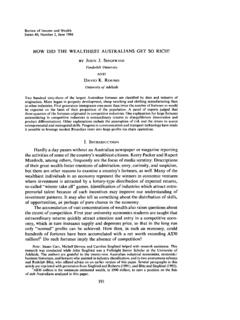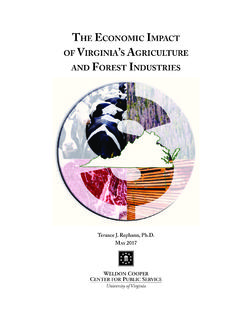Transcription of THE PRIMARY, SECONDARY, TERTIARY AND
1 THE primary , secondary , TERTIARY AND quaternary SECTORS OF THE ECONOMY US. Federal Reserve Board The recognition of differences among the major sectors of the economy, such as agriculture, commerce, or manufacturing, has a considerable tradition in economic thinking. Also, there is evidence that important national and international predicaments of our time are closely related to sectoral-structural developments. Yet economists in the developed countries are often disinclined to study the shifts among the megasectors.
2 This paper suggests that an intensified study of the topic may be profitable. In order to support this proposition it first reflects on the traditions of sectoral emphasis in literature. Second, it considers the evidence for the ascendancy of the quaternary activities. Third, it deals with the input-output relations among the four megasectors of the economy. Thereafter it points to the emergence of potential inefficiencies among quaternary activities and raises the possibility of a megasector misequili- brium. Finally it outlines certain connections to the thoughts of Leontief and Sraffa; considers services in the neoclassical framework; explores the relationships to institutional thought; and ponders the extension of its basic hypothesis to the developing nations, the socialist countries, and to historical analysis.
3 The ascendancy of service output for the 20th century and its growing share in total activity is as important an economic development as the industrial revolution and the growing share of manufacturing were for the preceding two centuries. The transition from preponderantly agricultural to industrial economies involved much economic, social and cultural stress within and among nations; it would be naive for our age to expect a smooth transition to the service econo nies in this and the next century. Many economic problems of our times are apparently related to the sectoral structural shifts in modern economies and therefore this topic deserves intensified study.
4 In particular we should understand better the input-output relationships of the key sectors; the economic inefficiencies that may be related to sectoral- structural adjustment problems; and the challenges to economic thinking posed by this major transformation of the world economy. Unfortunately economists in the developed countries today are often disin- clined to research the major sectoral-structural characteristics of production and even to accept the existence of analytically useful industrial distinctions among the main sectors of the economy.
5 ' Yet, making industrial distinctions among *The views expressed in this paper are those of the author and do not necessarily represent those of the Board or the staff of the Federal Reserve System. 'In the developing countries, and in the socialist economies, the sectoral structure of their economies is more often analyzed mainly because of the needs felt for industrialization and the often backward state of agriculture. sectors has a considerable tradition in economic thinking. Such thoughts may have been flawed, but nevertheless may have contained certain kernels of truth.
6 A search for these may be profitable. The relative characteristics of major economic sectors, such as agriculture, commerce and manufacturing, have been pondered by the mercantilists and the physicocrats and since Sir William Petty's time eminent economists have often devoted effort to evaluating the impact of shifts among major economic sectors. The relative neglect of the subject in the last two decades is almost unprecedented. The notion that different major economic sectors and activities may be of varying importance for overall economic activity and well-being goes back to preceding millenia.
7 For example in ancient China usually four basic classes or categories of people were recognized, and among these, persons involved in agriculture were ranked higher than agents of commerce.' In ancient Greece one finds similar distinctions in Aristotle, who accepted agriculture and household management as honorable, but frowned upon certain other activities such as trade and deplored moneylending because it involved usury. Scholastic tradition in Medieval Europe followed in the footsteps of Aristotle and canon law outlawed usury and denounced trade as a sinful occupa- tion.
8 "The scholastic Doctors extolled agriculture as an occupation leading to virtue, but shared all the prejudices of Aristotle and of the Church Fathers against trade."3 In later times Francois Quesnay in the famous Tableaux Economiques (about 1756) suggested that the net product of society was produced by the productive class (engaged in agriculture, fishing and mining), while the pro- prietary class (such as landowners) and the sterile or artisan class could serve public purposes and at best would recover its outlay.
9 In his scheme "the expansion of the economy and the population therefore depended upon expansion of the expenditure of the productive class and the resultant expansion of the net produ~t."~ In England, well before Quesnay, already in 1691 Sir William Petty concluded that "There is much more to be gained by Manufacture than Husbandry; and by Merchandise than Manufacture .."' But in 195i, some 260 years later, Colin Clark correctly lamented "that most of the world still remains quite unaware of the significance of Petty's brilliant and entirely correct generalization made from 2" Among those who performed physical labor, farmers were held to be the most productive and therefore their status came next to that of scholars.
10 Artisans and merchants, whose efforts were considered less productive, had an unfavorable position and were looked down upon by society, especially by the intellectuals." Slaves, prostitutes, entertainers, music players-depending on regional definitions-"were considered non-productive and as making the least contribution to society." T'ung-Tsu Ch'u "Chinese Class Structure and It's Ideology," in John K. Fairbank, Chinese Thought and Institutions, the University of Chicago Press, 1973, p. 247 and p. 249. We also know of the Edict of Emperor Wen on the Primacy of Agriculture in 163 and of other references regarding the encouragement of agriculture.








